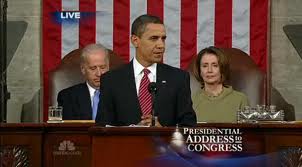The annual State of the Union address is tonight, and it is one of those truly interesting looks at the way our government works.
Article II, Section 3 of the United States Constitution states that the President “shall from time to time give to the Congress information of the state of the union, and recommend to their consideration such measures as he shall judge necessary and expedient,” and George Washington set the precedent that this should be done on a yearly basis. Over the course of our nation’s history, some president’s have delivered speeches while others have simply delivered letters to Congress.
While many believe this idea of bringing together everyone is a little outdated, it is a good practice for both the President and business leaders alike.
Formal versus informal communication
I was in Washington D.C. during last year’s State of the Union, and it was a big deal. While I had commitments before and during the actual address, the entire city was abuzz with activity afterward. It wasn’t quite like winning a sports championship or anything like that, but every place I went into had commentary about the speech on.
 Now, let’s not amplify its importance outside of Washington D.C. Many people’s interest were that of self-interest. Quite a few people in Washington owe their livelihood to the federal government, and seeing the CEO of the government on the big stage talking about priorities is bound to get the attention of these people.
Now, let’s not amplify its importance outside of Washington D.C. Many people’s interest were that of self-interest. Quite a few people in Washington owe their livelihood to the federal government, and seeing the CEO of the government on the big stage talking about priorities is bound to get the attention of these people.
What’s really interesting is that very few new things are unveiled at these speeches, but the big difference is how they are communicated. Namely, the State of the Union is very formal and watched by millions, while the appearances by the president where he may have mentioned a new program or announcements of pending legislation are usually scattered in the news.
Stoking people’s natural curiosity
Similarly, when Steve Jobs announces a new Apple product at a formal event, people pay attention. Even people outside of technology journalism hear the news. People who dislike Apple products even get the news. Similarly, look at awards shows like the Academy Awards or the Golden Globes with red carpets, formal speeches, and spiffy outfits.
Now the announcement itself at big formal event (whether it be a new iPhone, best actress or a new government program) might be buzzworthy enough, but adding these formal or theatrical elements to a piece of news are intended to captivate people rather than allow them to pass it by without a thought. And the part about it being intentional is where the lessons can be learned.
Speaking to your employees intentionally
When a CEO speaks casually at a meeting, you’re probably going to have the attention of the attention of the room just fine. Yet, there is something different about calling an all hands meeting, grabbing a podium, and giving a state of the company address. I’ve had many casual conversations with CEO’s while working at companies, and there is a different level of attention given when it is set up as an event to speak to everyone.
The intentional part of it is changing the dynamic and environment that you might get the news from. While an e-mail might be effective at communicating how and when a new program is being implemented, it is easy to pass this off. Yet, announce that same new program in front of an audience of hundreds and suddenly it becomes the most important news of the year. People remember more details and there is a shared experience of the announcement.
While your announcement might not be about an iPad or tax cuts, consider the venue when you’re communicating important items about your business. It’s at least one lesson you can learn from Washington and the State of the Union tonight.
